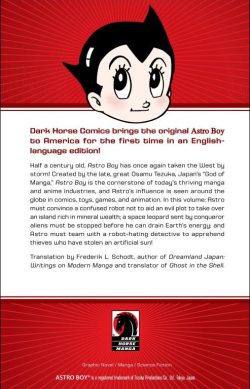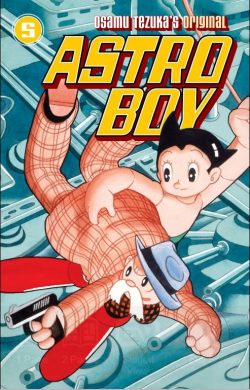 c
c
By Osamu Tezuka, translated by Frederik L. Schodt (Dark Horse Manga)
ISBN: 978-1-56971-680-9 (TPB)
From beginning his professional career in the late 1940s until his death in 1989, Osamu Tezuka generated an incomprehensible volume of quality work which transformed the world of manga and how it was perceived in his own country and, ultimately, across the globe. Devoted to Walt Disney’s creations, he performed similar sterling service with Japan’s fledgling animation industry.
The earliest stories were intended for children but right from the start Tezuka’s expansive fairy tale stylisations harboured more mature themes and held hidden pleasures for older readers and the legion of fans growing up with his manga masterpieces…
“The God of Comics†was born in Osaka Prefecture on November 3rd 1928, and as a child suffered from a severe illness. The doctor who cured him inspired the lad to study medicine, and although Osamu began drawing professionally whilst at university in 1946, he persevered with college and qualified as a medical practitioner too. Then, as he faced a career crossroads, his mother advised him to do the thing which made him happiest.
He never practiced as a healer but the world was gifted with such masterpieces as Kimba the White Lion, Buddha, Black Jack and so many other graphic narratives.
Working ceaselessly over decades, Tezuka and his creations inevitably matured, but he was always able to speak to the hearts and minds of young and old equally. His creations ranged from the childishly charming to the distinctly disturbing such as The Book of Human Insects.
Tezuka died on February 9th 1989, having produced more than 150,000 pages of timeless comics, created the Japanese anime industry and popularised uniquely Japanese graphic narrative which became a fixture of world culture.
This fifth monochrome digest volume (173 x 113 mm in the physical world and any size you like if you get the eBook edition) continues to present – in non-linear order – early exploits of his signature character, with the emphasis firmly on fantastic fun and family entertainment…
Tetsuwan Atomu (literally “Mighty Atom†but known universally as Astro Boy due to its dissemination around the world as an animated TV cartoon and one of post-war Japan’s better exports) is a spectacular, riotous, rollicking sci fi action-adventure starring a young boy who also happens to be one of the mightiest robots on Earth.
The series began in 1952 in ShÅnen Kobunsha and ran until March 12th 1968 – although Tezuka often returned to add to the canon in later years. Over that period, Astro spawned the aforementioned global TV cartoon boom, starred in comicbook specials and featured in games, toys, collectibles, movies and the undying devotion of generations of ardent fans.
Tezuka frequently drew himself into his tales as a commentator, and in his later revisions and introductions often mentioned how he found the restrictions of ShÅnen comics stifling; specifically, having to periodically pause a plot to placate the demands of his audience by providing a blockbusting fight every episode. That’s his prerogative: most of us avid aficionados have no complaints…
Tezuka and his production team were never as wedded to close continuity as fans are. They constantly revised both stories and artwork in later collections, so if you’re a purist you are just plain out of luck. Such tweaking and modifying is the reason this series seems to skip up and down the publishing chronology. The intent is to entertain at all times so stories aren’t treated as gospel and order is not immutable or inviolate.
It’s just comics, guys…
And in case you came in late, here’s a little background to set you up…
In a world where robots are ubiquitous and have won (limited) human rights, brilliant Dr. Tenma lost his son Tobio in a traffic accident. Grief-stricken, the tormented genius used his position as head of Japan’s Ministry of Science to build a replacement. The android his team created was one of the most ground-breaking constructs in history, and for a while Tenma was content.
However, as his mind re-stabilised, Tenma realised the unchanging humanoid was not Tobio and, with cruel clarity, summarily rejected the replacement. Ultimately, the savant removed the insult to his real boy by selling the robot to a shady dealer…
One day, independent researcher Professor Ochanomizu was in the audience at a robot circus and realised diminutive performer “Astro†was unlike the other acts – or indeed, any artificial being he had ever encountered. Convincing the circus owners to part with the little robot, the Prof closely studied the unique creation and realised just what a miracle had come into his hands…
Part of Ochanomizu’s socialization process for Astro included placing him in a family environment and having him attend school just like a real boy. As well as providing friends and admirers the familiar environment turned up another foil and occasional assistant in the bellicose form of Elementary School teacher Higeoyaji (AKA Mr. Mustachio)…
The wiry wonder’s astonishing exploits resume after the now traditional ‘A Note to Readers’ – explaining why one thing that hasn’t been altered is the depictions of various racial types in the stories.
‘Crucifix Island’ originally ran January through April, 1957 in ShÅnen Magazine and begins with an explanation of why most robots are generally humanoid before concentrating on obsessive Doctor Tozawa who channelled his ancient ninja lineage to create an ultimate shape-changing mechanoid. He was interrupted and arrested before he could complete his masterpiece but that was then and this is now where our story properly begins…
Following a manic prison break, Tozawa and his new crooked cronies wash up on and take over a desolate island housing one hundred thousand robots operating the deepest and most sophisticated uranium mine on Earth. The merest by-product is a daily fortune in other precious ores and gems…
Meanwhile, at the Isle’s Robot School Astro is having problems with another young automaton. Pook is troubled because he’s incomplete: his “father†was arrested and imprisoned before he could make his boy perfect…
When Pook and Tozawa are reunited, the mad scientist ambushes Astro, harvesting his body for the parts needed to complete his dream robot. The troubled mechanoid finally gains the power to change shape…
Sadly, one thing that never changes is human greed and Tozawa’s fellow fugitives turn on him when he ignores their pleas to plunder the discarded mountain of gems. Inviting their army of criminal comrades to take over the island, they try to kill the now repentant technologist. With his breath fading, the Doctor repairs Astro to tackle the thieves, but nobody anticipated Pook’s reaction to gaining his full powers or how that would affect the multitude of lethal digging robots…
After a tremendous battle order is eventually restored but not everybody makes it out alive…
Running in ShÅnen Magazine from February to April 1960, ‘Space Snow Leopard’ details how frosty precipitation across Earth steals energy from robots and machines. Seemingly unaffected, Astro is challenged by a space wizard and his six-legged killer feline Lupe, but barely escapes as they continue softening up the planet for an alien takeover.
On the run, Astro consults his school friends hoping organic humanity can prevail against the bizarre duo. Ultimately however it takes humans and robots working together and the invention of a giant amalgamated mecha comprised of many smaller automatons working in unison to save the world…
‘The Artificial Sun’ first ran between December 1959 and February 1960 and concludes this compilation in glorious style as a ship at sea reports a deadly floating fireball causing weather disruptions. Fearing the worst, the International Council of Police Organizations consult super-cop Sherlock Holmspun to tackle the crisis. His pride in in a swift breakthrough is soon scotched, however, when the council insist he take along some competent backup/additional firepower in the form of a robot codenamed Mighty Atom …
With the game afoot, the odd couple track down prime suspect Professor Hirata and his deadly monster, but will Holmspun’s prejudice jeopardise the mission… or will his dreadful secret shame leave them all unable to fight off the deadly fireball beast and the real culprit behind it?
Breathtaking pace, outrageous invention, slapstick comedy, heart-wrenching sentiment and frenetic action are the hallmarks of these captivating comics constructions: perfect examples of Tezuka’s uncanny storytelling gifts, which can still deliver a potent punch and instil wide-eyed wonder on a variety of intellectual levels.
Tetsuwan Atom by Osama Tezuka © 2002 by Tezuka Productions. All rights reserved. Astro Boy is a registered trademark of Tezuka Productions Co., Ltd., Tokyo Japan. Unedited translation © 2002 Frederik L. Schodt.
